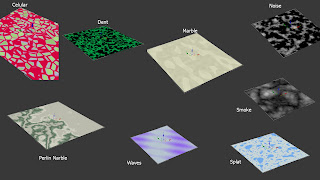The first task for this week was to make two materials that look like they are made out of wood and metal.
The first material is wood. The material has a low secular level and glossiness because wood is not shiny like metal.
The second material is metal. The secular level Is much higher as it makes the metal looks more reflective. If I put the glossiness up to high I end up with more of a plastic look so I kept it low, but higher than the glossiness I used for the wood material.
The next task was to experiment with the different procedural maps. The good thing about procedural maps are that they never lose resolution unlike bitmaps, but you cant put as much details in to the materials unlike bitmaps.
When materials are applied on different shapes they don’t tile up, and the materials gets stretch.
Sphere-BOX mapping: The Image is trying to apply it self to a 6 sided shape, but as the sphere is round the sections are overlapping each other.
Sphere-SPHERICAL mapping: The images is warped around the object, so the sides meet from the top of the sphere all the way to the bottom. As the images is lighter on one side you can see the line going from the top to the bottom.Sphere-SHRINK WRAP: All of the corners of the image meet at the bottom part of the sphere.
Cylinder-CYLINDER mapping: Warps the image around the sides.
Cylinder-CYLINDER mapping with CAP: Warps the image around the sides, but also adds the image on the top and bottom faces.
Teapot -FACE mapping: Maps the image on every polygon of the shape.
Teapot-SPHERICAL mapping: I found that the spherical mapping on the teapot was the best choice to have the image warp around the object.
The last task for this week was to make a cloud material using procedural maps. The material is made out of two procedural maps, combined with a mask to make some transparent holes. This material would be also good for smoke.






No comments:
Post a Comment